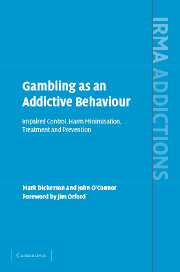Book contents
- Frontmatter
- Contents
- Preface
- Declaration
- Executive Summary
- Glossary
- Foreword
- List of Tables
- List of Figures
- 1 The Research Context
- 2 Research into Impaired Control of Gambling Behaviour, Definition and Measurement: Traditional Psychometric and Mathematical Psychology Approaches
- 3 Impaired Control and its Relationship to other Variables Implicated in the Development of Pathological Gambling
- 4 Models of Impaired Self-Control of Gambling
- 5 Implications for Treatment Approaches to Problem Gambling Arising from the Model of Impaired Control
- 6 Implications for Harm Minimisation in the Management of Problem Gambling: Making Sense of “Responsible Gambling”
- 7 A Case Study of “Responsible Gambling” Strategies within a Single Jurisdiction: Victoria, Australia
- 8 Conclusions
- References
- Index
7 - A Case Study of “Responsible Gambling” Strategies within a Single Jurisdiction: Victoria, Australia
Published online by Cambridge University Press: 07 September 2009
- Frontmatter
- Contents
- Preface
- Declaration
- Executive Summary
- Glossary
- Foreword
- List of Tables
- List of Figures
- 1 The Research Context
- 2 Research into Impaired Control of Gambling Behaviour, Definition and Measurement: Traditional Psychometric and Mathematical Psychology Approaches
- 3 Impaired Control and its Relationship to other Variables Implicated in the Development of Pathological Gambling
- 4 Models of Impaired Self-Control of Gambling
- 5 Implications for Treatment Approaches to Problem Gambling Arising from the Model of Impaired Control
- 6 Implications for Harm Minimisation in the Management of Problem Gambling: Making Sense of “Responsible Gambling”
- 7 A Case Study of “Responsible Gambling” Strategies within a Single Jurisdiction: Victoria, Australia
- 8 Conclusions
- References
- Index
Summary
The Introduction of Gaming Machines
In this chapter the “case” of the State of Victoria in Australia is presented: the decade from 1992 onwards when first electronic gaming machines (EGMs) and then a casino were made legally available, the population changes in the gambling attitudes and behaviours, the economic impacts and the complex set of social policies that were developed to assess, manage and prevent the harmful impacts arising from gambling. This “case” is intended neither as a moral argument nor a salutary tale, merely a description of a relatively small jurisdiction (3.6 million aged 15 years and older; ABS, 2003 census data) reacting politically and socially to the introduction of 30,000 EGMs. In the same period, of all the states and territories in Australia in which occurred similar changes in the availability of EGMs, the response of Victoria has been the most comprehensive, arguably setting International benchmarks in research, service delivery and harm minimisation (note possible conflict of interest for MD; see declaration at Preface).
The “snapshot” of Victoria provided by the 2001 census data (ABS, 2003) locates about one quarter of the Australian population in this state on the south-eastern corner of the continent. The 0.5% of the 4.6 million is of Indigenous origin, 52% are married (or de facto), 71% Australian born and over 80% dwell in urban settings.
- Type
- Chapter
- Information
- Gambling as an Addictive BehaviourImpaired Control, Harm Minimisation, Treatment and Prevention, pp. 124 - 137Publisher: Cambridge University PressPrint publication year: 2006

